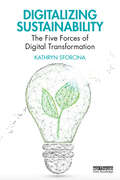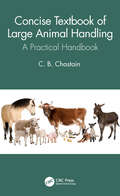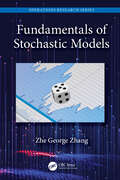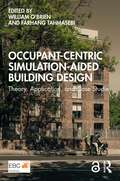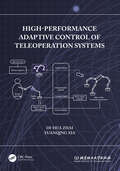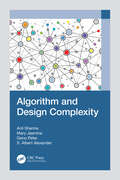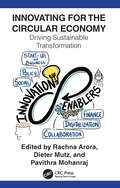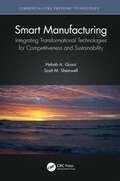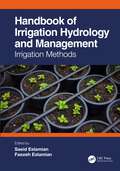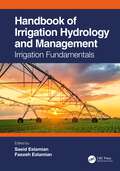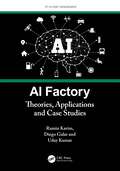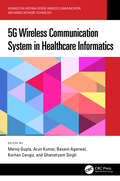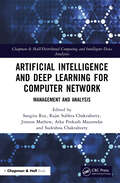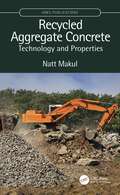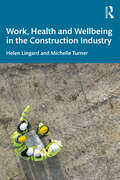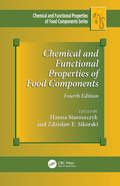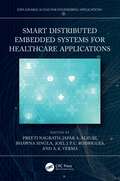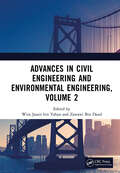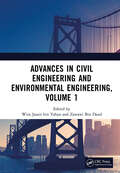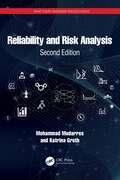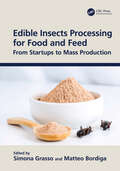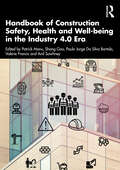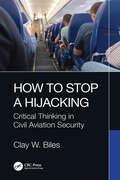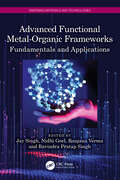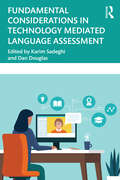- Table View
- List View
Digitalizing Sustainability: The Five Forces of Digital Transformation
by Kathryn SforcinaDigitalizing Sustainability outlines why ‘business as usual’ isn't working and sets out five Transformational Forces which can be used to innovate and scale sustainability solutions using digital means. This transformation will be powered by a range of digital technologies that have the potential to ideate, propel and scale sustainability solutions in an exponential manner over the next decade. This book introduces the Five Forces of Digital Transformation. These forces all share a common root – they are powered by digital technologies that enable them to operate at the speed and scale that we need to achieve global transformation for people and planet. Working together, these forces help overcome many of the barriers and pitfalls that humanity has faced in trying to achieve sustainability 2.0 and will help you tackle these questions: Why has sustainability 1.0 failed us? What are the bugs and bad code in our operating systems that we must address to have any hope of creating a sustainable civilization? What are the Five Forces of Digital Transformation that will forge a sustainable and resilient future for our people and planet? What are the core priorities going forward for coalitions of the willing to harness these forces for sustainability and resilience? Disruptive and innovative, this book provides readers with a clear path forward to a sustainable digital future. It will be of great interest to anyone interested in the adoption of digital technologies for driving solutions to global sustainability challenges.
Concise Textbook of Large Animal Handling: A Practical Handbook
by C. B. ChastainThis concise instructional guide condenses the most important aspects of large animal handling. It provides a portable, durable, beside-the-animal means of learning, as well as a convenient way to refresh on how to strive for safety and efficacy in animal handling techniques. It is ideal for use during veterinary placements in all settings from farm to laboratory, to riding school. The text covers: • Handler safety • Animal safety • Sanitation • Approach and capture • Routine handling and release procedures • Handling for medical procedures • Use and supply sources of restraint equipment A Companion Website provides additional self-assessment questions and answers to aid learning. Important reading for undergraduate veterinary students on EMS rotations, as well as practicing veterinarians, technicians, and assistants, the book covers species encountered in farm, equine, and laboratory settings.
Fundamentals of Stochastic Models (Operations Research Series)
by Zhe George ZhangStochastic modeling is a set of quantitative techniques for analyzing practical systems with random factors. This area is highly technical and mainly developed by mathematicians. Most existing books are for those with extensive mathematical training; this book minimizes that need and makes the topics easily understandable. Fundamentals of Stochastic Models offers many practical examples and applications and bridges the gap between elementary stochastics process theory and advanced process theory. It addresses both performance evaluation and optimization of stochastic systems and covers different modern analysis techniques such as matrix analytical methods and diffusion and fluid limit methods. It goes on to explore the linkage between stochastic models, machine learning, and artificial intelligence, and discusses how to make use of intuitive approaches instead of traditional theoretical approaches. The goal is to minimize the mathematical background of readers that is required to understand the topics covered in this book. Thus, the book is appropriate for professionals and students in industrial engineering, business and economics, computer science, and applied mathematics.
Occupant-Centric Simulation-Aided Building Design: Theory, Application, and Case Studies
by William O’Brien Farhang TahmasebiOccupant-Centric Simulation-Aided Building Design promotes occupants as a focal point for the design process. This resource for established and emerging building designers and researchers provides theoretical and practical means to restore occupants and their needs to the heart of the design process. Helmed by leaders of the International Energy Agency Annex 79, this edited volume features contributions from a multi-disciplinary, globally recognized team of scholars and practitioners. Chapters on the indoor environment and human factors introduce the principles of occupant-centric design while chapters on selecting and applying models provide a thorough grounding in simulation-aided building design practice. A final chapter assembling detailed case studies puts the lessons of the preceding chapters into real-world context. In fulfillment of the International Energy Agency’s mission of disseminating research on secure and sustainable energy to all, Occupant-Centric Simulation-Aided Building Design is available as an Open Access Gold title. With a balance of fundamentals and design process guidelines, Occupant-Centric Simulation-Aided Building Design reorients the building design community toward buildings that recognize and serve diverse occupant needs, while aiming for superior environmental performance, based on the latest science and methods.
High-Performance Adaptive Control of Teleoperation Systems
by Yuanqing Xia Di-Hua ZhaiWithin a unified switched-control framework, this book investigates the high-performance control designs and theoretic analyses for teleoperation systems, including the joint space and task space teleoperations, the homogeneous and heterogeneous teleoperations, and the single-master single-slave and multi-master multi-slave teleoperations.The book begins with an introduction to the concepts and challenges of networked teleoperation systems. Then, it investigates a new adaptive control framework based on auxiliary switched filters for the bilateral teleoperation systems to handle the model uncertainty and non-passive external forces. To overcome the input constraints of robotic systems, this adaptive method is also extended to the anti-windup adaptive control case. Furthermore, to apply to multi-robot remote collaboration scenarios and heterogeneous teleoperations, two tele-coordination methods and an adaptive semi-autonomous control method are respectively developed. Finally, the authors examine two finite-time control schemes and two types of improved prescribed performance controls for teleoperation systems to improve the transient-state and steady-state synchronization performances.This title will be an essential reference for researchers and engineers interested in teleoperation, robotic systems, and nonlinear control systems. It would also prove useful to graduate students in the fields of science, engineering, and computer science.
Algorithm and Design Complexity
by S. Albert Alexander Anli Sherine Mary Jasmine Geno PeterComputational complexity is critical in analysis of algorithms and is important to be able to select algorithms for efficiency and solvability. Algorithm and Design Complexity initiates with discussion of algorithm analysis, time-space trade-off, symptotic notations, and so forth. It further includes algorithms that are definite and effective, known as computational procedures. Further topics explored include divide-and-conquer, dynamic programming, and backtracking. Features: Includes complete coverage of basics and design of algorithms Discusses algorithm analysis techniques like divide-and-conquer, dynamic programming, and greedy heuristics Provides time and space complexity tutorials Reviews combinatorial optimization of Knapsack problem Simplifies recurrence relation for time complexity This book is aimed at graduate students and researchers in computers science, information technology, and electrical engineering.
Innovating for The Circular Economy: Driving Sustainable Transformation
by Rachna Arora, Dieter Mutz, and Pavithra MohanrajSystemic change is required to move to a circular economy (CE) model which can meet the demands of a growing population in a manner that is decoupled from resource use and waste generation. This book takes a deep dive into the innovation aspect of the circular economy (CE), with a specific focus on India as a geography, where the transformation to a circular economy is underway. How a developing country like India is tackling the complexities of the transformation and creating innovative solutions is showcased in this book through many practical examples and inspirational case studies. The book lays out the foundations for mainstreaming resource efficiency (RE)/CE in India, and covers innovation led by businesses and start-ups, along with the innovative policies, financing, and collaborative models required to spur and accelerate circular economy approaches, while also providing linkages to the international context. Features: Provides insight into the role of innovation in the circular economy transition Helps to develop and facilitate adoption of resource-efficiency policy and strategy with particular focus on key resource sectors and waste streams Treats the circular economy as a holistic approach across the entire lifecycle, and places emphasis on upstream interventions and systems change Examines the current context of COVID-19 and its impact on circular economy models and practices Touches upon how the EU-based approach was adapted and contextualised significantly to work in the unique Indian landscape This book is aimed at students, researchers, and professionals engaged in the domains of circular economy, sustainability, business innovation, environmental studies, natural resources management, and environmental and resource conservation policy.
Smart Manufacturing: Integrating Transformational Technologies for Competitiveness and Sustainability (Commercializing Emerging Technologies)
by Hebab A. Quazi Scott M. ShemwellThe manufacturing industries remain the foundation of local, regional, and global economies. Manufacturing plants operate in dynamic markets that demand upgrading with transformational technologies for maintaining profitability, competitiveness, and business sustainability. Yet most manufacturing plants currently use technologies that are no longer competitive, and industry leaders face an overwhelming array of operational challenges that require agile and enhanced transformational solutions. This book offers manufacturers effective strategies and tools for the adoption and implementation of advanced operational technologies to ensure long-term innovation, efficiency, and profitability. Covers advanced automation integration in manufacturing, including digitization, AI, machine learning, IIoT, and cybersecurity Describes innovation, development, and integration of control technologies for sustainable manufacturing Explains how to upgrade existing manufacturing plants for the global market Shows how to apply emerging technologies including asset optimization and process integration for product lifecycle improvements, plant operation and maintenance enhancement, and supply chain integration This book serves as a strategic guide to applying advanced operational technologies for engineers, industry professionals, and management in the manufacturing sector.
Handbook of Irrigation Hydrology and Management: Irrigation Methods
by Saeid Eslamian Faezeh EslamianEver-increasing population growth has caused a proportional increased demand for water, and existing water sources are depleting day by day. Moreover, with the impact of climate change, the rates of rainfall in many regions have experienced a higher degree of variability. In many cities, government utilities have been struggling to maintain sufficient water for the residents and other users. The Handbook of Irrigation Hydrology and Management: Irrigation Methods examines and analyzes irrigated ecosystems in which water storage, applications, or drainage volumes are artificially controlled in the landscape and the spatial domain of processes varies from micrometers to tens of kilometers, while the temporal domain spans from seconds to centuries. The continuum science of irrigation hydrology includes the surface, subsurface (unsaturated and groundwater systems), atmospheric, and plant subsystems. Further, the book addresses the best practices for various types of irrigation methods including pressure, smart, surface, and subsurface, and presents solutions for water scarcity and soil salinity in irrigation.Features: Offers water-saving strategies to increase the judicious use of scarce water resources Presents strategies to maximize agricultural yield per unit of water used for different regions Compares irrigation methods to offset changing weather patterns and impacts of climate change
Handbook of Irrigation Hydrology and Management: Irrigation Fundamentals
by Saeid Eslamian Faezeh EslamianEver-increasing population growth has caused a proportional increased demand for water, and existing water sources are depleting day by day. Moreover, with the impact of climate change, the rates of rainfall in many regions have experienced a higher degree of variability. In many cities, government utilities have been struggling to maintain sufficient water for the residents and other users. The Handbook of Irrigation Hydrology and Management examines and analyzes irrigated ecosystems in which water storage, applications, or drainage volumes are artificially controlled in the landscape and the spatial domain of processes varies from micrometers to tens of kilometers, while the temporal domain spans from seconds to centuries. The continuum science of irrigation hydrology includes the surface, subsurface (unsaturated and groundwater systems), atmospheric, and plant subsystems. Further, the book includes coverage of environmental and economic impacts, water quality issues, water harvesting, satellite measurements for irrigation, and more. Features: Offers water-saving strategies to increase the judicious use of scarce water resources Presents strategies to maximize agricultural yield per unit of water used for different regions Compares irrigation methods to offset changing weather patterns and impacts of climate change
AI Factory: Theories, Applications and Case Studies (ICT in Asset Management)
by Uday Kumar Diego Galar Ramin KarimThis book provides insights into how to approach and utilise data science tools, technologies, and methodologies related to artificial intelligence (AI) in industrial contexts. It explains the essence of distributed computing and AI technologies and their interconnections. It includes descriptions of various technology and methodology approaches and their purpose and benefits when developing AI solutions in industrial contexts. In addition, this book summarises experiences from AI technology deployment projects from several industrial sectors. Features: Presents a compendium of methodologies and technologies in industrial AI and digitalisation. Illustrates the sensor-to-actuation approach showing the complete cycle, which defines and differentiates AI and digitalisation. Covers a broad range of academic and industrial issues within the field of asset management. Discusses the impact of Industry 4.0 in other sectors. Includes a dedicated chapter on real-time case studies. This book is aimed at researchers and professionals in industrial and software engineering, network security, AI and machine learning (ML), engineering managers, operational and maintenance specialists, asset managers, and digital and AI manufacturing specialists.
5G Wireless Communication System in Healthcare Informatics (Advances in Antenna Design, Wireless Communication and Mobile Network Technology)
by Manoj Gupta Basant Agarwal Ghanshyam Singh Arun Kumar Korhan CengizThis text discusses problems and needs with the implementation of a 5G mobile communications system in the healthcare sector. It covers the issues related to advanced modulation schemes, telehealth, and remote diagnosis. It discusses important topics including virtual healthcare monitoring, spectrum sensing techniques, the role of 5G in medical applications, the role of nano- communication in healthcare informatics, and remote diagnosis. The text will be useful for graduate students, academic researchers, and professionals in the fields of electrical, and electronics and communication engineering, and allied healthcare. This book: Discusses novel architecture to manage the allocation of resources, and the interference issue among existing and advanced radios Provides focus to estimate the performance, cost and accommodation of the next generation technology design for the IoT, modern health- care, and education Covers advanced technologies and their role in healthcare Discusses key topics including spectrum access, advanced waveforms, which can help in standardization of 5G based smart hospital Explores the impact of telemedicine in smart healthcare This reference text covers the latest advances in the field of 5G mobile communication for healthcare informatics, addressing both original algorithm development and new applications of 5G mobile Communications.
Artificial Intelligence and Deep Learning for Computer Network: Management and Analysis (Chapman & Hall/Distributed Computing and Intelligent Data Analytics)
by Rajat Subhra Chakraborty Jimson Mathew Arka Prokash Mazumdar Sudeshna Chakraborty Sangita RoyArtificial Intelligence and Deep Learning for Computer Network: Management and Analysis aims to systematically collect quality research spanning AI, ML, and deep learning (DL) applications to diverse sub-topics of computer networks, communications, and security, under a single cover. It also aspires to provide more insights on the applicability of the theoretical similitudes, otherwise a rarity in many such books. Features: A diverse collection of important and cutting-edge topics covered in a single volume. Several chapters on cybersecurity, an extremely active research area. Recent research results from leading researchers and some pointers to future advancements in methodology. Detailed experimental results obtained from standard data sets. This book serves as a valuable reference book for students, researchers, and practitioners who wish to study and get acquainted with the application of cutting-edge AI, ML, and DL techniques to network management and cyber security.
Recycled Aggregate Concrete: Technology and Properties (IOM3 Publications)
by Natt MakulRecycled Aggregate Concrete (RAC) as a sustainable material is gaining increasing importance in the construction industry. This book discusses properties, specifications, and applications of RAC and offers readers insight into current research and advances in the development and utilization of RAC. It shares information gathered about concretes that use RCA (Recycled Concrete Aggregate, a component of RAC), as well as findings and conclusions. This book: • Presents principles of RAC, including theories and experiments • Describes advanced behavior and properties • Covers specifications and codes • Highlights best practices • Summarizes the use of RAC in sustainable concrete construction • Features scientific findings, citations of reliable sources, conclusions, and recommendations that ensure the book is accessible to various levels of expertise This book will be useful for researchers, concrete scientists, technologists, practicing engineers, and advanced students interested in reusing construction waste for sustainable construction practices; it will help them strive toward meeting the UN Sustainable Development Goals (SDGs).
Work, Health and Wellbeing in the Construction Industry
by Michelle Turner Helen LingardThis book covers a wide range of topics relating to the health and wellbeing of the construction workforce. Based on more than two decades of work examining various aspects of workers’ health and wellbeing, the book addresses a key topic in construction management: how the design of work environments, construction processes and organisation of work impact upon construction workers’ physical and psychological health. Occupational health is a significant problem for the construction industry. However, the subject of health does not receive as much attention in occupational health and safety research or practice as the subject of safety. Traditional management approaches (focused on the prevention of accidents and injuries) are arguably ill-suited to addressing issues of workers’ health and wellbeing. This book seeks to explain how workers' health and wellbeing are impacted by working in the construction industry, and suggest ways in which organisations (and decision makers within them) can positively shape workplaces and practices in ways that better support constructions workers to maintain healthy and productive working lives. Including chapter summaries and discussion questions to encourage student readers to reflect on and formulate their own viewpoints about the issues raised in each chapter, the book has the potential to be used as a textbook in undergraduate or postgraduate occupational health and safety, or construction management courses dealing with occupational health and safety. It could also be used as supplementary recommended reading in undergraduate or postgraduate programmes in architecture, engineering or management.
Chemical and Functional Properties of Food Components (Chemical & Functional Properties of Food Components)
by Hanna Staroszczyk and Zdzisław E. SikorskiOver three editions, this book described the contents of food raw materials and products, the chemistry/biochemistry of food components, as well as the changes occurring during post-harvest storage and processing affecting the quality of foods. The fourth edition of Chemical and Functional Properties of Food Components discusses the role of chemical compounds in the structure of raw materials and the formation of different attributes of food quality, including nutritional value, safety, and sensory properties. This new edition contains four new chapters: “Non-Protein Nitrogenous Compounds”; “Prooxidants and Antioxidants in Food”; “Non-Nutritive Bioactive Compounds in Food of Plant Origin”; and “Analytical Methods Used for Assessing the Quality of Food Products.” These chapters have been included because new research results have brought increasing knowledge on the effect of non-protein nitrogenous compounds, especially bioactive peptides, nucleic acids, and biogenic amines on the biological properties of foods; the role of natural and added prooxidants and antioxidants in the processing and biological impact of foods; numerous beneficial and harmful effects of bioactive components of plant foods; and new systems for control of food composition and the safety of foods. Features: • Stresses the effect of the chemical/biochemical reactions on the selection of optimum parameters of food processing without presenting details of the technological processes • Describes naturally occurring elements and compounds as well as those generated during food handling in view of health hazards they may bring to consumers • Discusses the risks and benefits of reactions occurring during food handling The knowledge of the chemistry and biochemistry of the components and their interactions presented in this book aids food scientists in making the right decisions for controlling the rate of beneficial and undesirable reactions, selecting optimal storage and processing parameters, as well as the best use of food raw materials.
Smart Distributed Embedded Systems for Healthcare Applications (Explainable AI (XAI) for Engineering Applications)
by Jafar A. Alzubi Joel J. P. C. Rodrigues Bhawna Singla Preeti Nagrath A. K. VermaThis book discusses the applications and optimization of emerging smart technologies in the field of healthcare. It further explains different modeling scenarios of the latest technologies in the healthcare system and compares the results to better understand the nature and progress of diseases in the human body, which would ultimately lead to early diagnosis and better treatment and cure of diseases with the help of distributed technology. Covers the implementation models using technologies such as artificial intelligence, machine learning, and deep learning with distributed systems for better diagnosis and treatment of diseases. Gives in-depth review of technological advancements like advanced sensing technologies such as plasmonic sensors, usage of RFIDs, and electronic diagnostic tools in the field of healthcare engineering. Discusses possibilities of augmented reality and virtual reality interventions for providing unique solutions in medical science, clinical research, psychology, and neurological disorders. Highlights the future challenges and risks involved in the application of smart technologies such as cloud computing, fog computing, IOT, and distributed computing in healthcare. Confers to utilize the AI and ML and associated aids in healthcare sectors in the post-Covid 19 period to revitalize the medical setup. Contributions included in the book will motivate technological developers and researchers to develop new algorithms and protocols in the healthcare field. It will serve as a vast platform for gaining knowledge regarding healthcare delivery, health- care management, healthcare in governance, and health monitoring approaches using distributed environments. It will serve as an ideal reference text for graduate students and researchers in diverse engineering fields including electrical, electronics and communication, computer, and biomedical fields.
Advances in Civil Engineering and Environmental Engineering, Volume 2: Proceedings of the 4th International Conference on Civil Engineering and Environmental Engineering (CEEE 2022), Shanghai, China, 26–28 August 2022
by bin Yahya, Wira Jazair Zawawi Bin DaudAdvances in Civil Engineering and Environmental Engineering focuses on the research of civil engineering and environmental engineering. The proceedings feature the most cutting-edge research directions and achievements related to civil engineering and environmental. Subjects in the proceedings include: Civil engineering technology Civil engineering surveying Geological engineering Structural engineering Tunnel and bridge engineering Environmental protection materials Pollution control project Building environment and equipment engineering The works of this proceedings can promote development of civil engineering and environmental engineering, resource sharing, flexibility and high efficiency. Thereby, promote scientific information interchange between scholars from the top universities, research centers and high-tech enterprises working all around the world.
Advances in Civil Engineering and Environmental Engineering, Volume 1: Proceedings of the 4th International Conference on Civil Engineering and Environmental Engineering (CEEE 2022), Shanghai, China, 26–28 August 2022
by bin Yahya, Wira Jazair Zawawi Bin DaudAdvances in Civil Engineering and Environmental Engineering focuses on the research of civil engineering and environmental engineering. the proceedings feature the most cutting-edge research directions and achievements related to civil engineering and environmental. Subjects in the proceedings include: Civil engineering technology Civil engineering surveying Geological engineering Structural engineering Tunnel and bridge engineering Environmental protection materials Pollution control project Building environment and equipment engineering The works of this proceedings can promote development of civil engineering and environmental engineering, resource sharing, flexibility and high efficiency. Thereby, promote scientific information interchange between scholars from the top universities, research centers and high-tech enterprises working all around the world.
Reliability and Risk Analysis: A Practical Guide, Third Edition (ISSN)
by Mohammad Modarres Katrina GrothCompletely updated for a new edition, this book introduces reliability and risks analysis, for both practicing engineers and engineering students at the undergraduate and graduate levels. Since reliability analysis is a multidisciplinary subject, this book draws together a wide range of topics and presents them in a way that applies to most engineering disciplines.What Every Engineer Should Know About Reliability and Risk Analysis, Second Edition, emphasizes an introduction and explanation of the practical methods used in reliability and risk studies, with a discussion of their uses and limitations. It offers basic and advanced methods in reliability analysis that are commonly used in daily practice and provides methods that address unique topics such as dependent failure analysis, importance analysis, and analysis of repairable systems. The book goes on to present a comprehensive overview of modern probabilistic life assessment methods such as Bayesian estimation, system reliability analysis, and human reliability. End-of-chapter problems and a solutions manual are available to support any course adoptions.This book is refined, simple, and focuses on fundamentals. The audience is the beginner with no background in reliability engineering and rudimentary knowledge of probability and statistics. It can be used by new practitioners, undergraduates, and first-year graduate students.
Edible Insects Processing for Food and Feed: From Startups to Mass Production
by Simona Grasso and Matteo BordigaConsumers around the world are becoming increasingly aware of the significant impacts of food consumption on the environment, and demand for more sustainable foods is expanding rapidly. Edible Insects Processing for Food and Feed: From Startups to Mass Production focuses on the growing topic of insects as food and feed, covering not only production elements, but also case studies and several other areas of interest, such as environmental aspects, nutritional value, consumers, food safety and market statistics. Key Features: Includes several case studies and latest advancements in the area Contains multidisciplinary approach, covering farm-to-fork aspects Contains full account of contemporary developments in mass production of edible insects Written by passionate leading academics and industry partners around the globe, this book aims to bring together the latest advancements in edible insect production in a dynamic, modern and multidisciplinary approach. It is a one-stop shop that will give readers a flavour of where the fascinating topic of edible insect production is now, but more importantly of where it might be heading to in the future, showcasing several related challenges and opportunities.
Handbook of Construction Safety, Health and Well-being in the Industry 4.0 Era
by Shang Gao Patrick Manu Anil Sawhney Valerie Francis Paulo Jorge Da Silva BartoloThis Handbook seeks to examine and advance current understanding of the confluence of construction health, safety and well-being and the broad range of Industry 4.0 technologies in use in the architecture, engineering and construction (AEC) industry. Globally, the construction sector accounts for more than 100,000 occupational fatalities annually. In many countries, reports of work-related accidents, injuries and illnesses are commonplace, and there is an urgent need to improve the occupational safety and health (OSH) outlook of the construction sector. The fourth industrial revolution presents opportunities to leverage modern technologies (e.g., big data, artificial intelligence, automation, sensors, AR, VR and robotics) to improve the poor OSH performance of the construction industry. However, embracing such technologies could also induce unintended adverse consequences for the safety, health and well-being of construction workers. Therefore, the realisation of the opportunities as well as the mitigation of potentially adverse consequences requires research-informed holistic insights around the union of Industry 4.0 and construction occupational safety and health management. This cutting-edge volume addresses a significant gap in literature by bringing together experienced academics and researchers to highlight the drivers, opportunities and drawbacks of the merging of Industry 4.0 with construction health, safety and well-being. After a detailed introductory section which highlights key issues and challenges, section one covers the application of a broad range of digital technologies; then section two discusses the application of industrial production and cyber physical systems in the context of construction safety and health management. Readers from a broad range of AEC backgrounds as well as safety professionals and technologists will come to understand how the technologies are applied and the resulting OSH benefits as well as potential drawbacks.
How to Stop a Hijacking: Critical Thinking in Civil Aviation Security
by Clay W. BilesHijackings and bombings have plagued civil aviation since 1930 and air rage incidents are on the rise. While there is aircraft and inflight training available for air marshals, other first responders receive minimal training on inflight security awareness and protocols. There are no other resources currently available to flight crews or armed first responders that specifically address inflight security and how to address threats of disturbances on airplanes.How to Stop a Hijacking provides readers with fundamental principles on how to think more critically about onboard security threats. The aircraft cabin poses unique environment and security challenges, and first responders can apply security awareness and critical thinking skills to establish a safer environment in the cabin and airport for everyone onboard. The lessons in this book are driven with the central objective of teaching the reader how to counter inflight aggression and maintain tactical control of the cabin. Written by a former federal air marshal instructor, this book looks at the recent rash of air rage incidents and violence on airplanes, in addition to the real and ever-present threat of hijack or potential explosive device.How to Stop a Hijacking is a practical guide that offers methodological and tactically proven strategies for stopping violent acts onboard an aircraft inflight.
Advanced Functional Metal-Organic Frameworks: Fundamentals and Applications (Emerging Materials and Technologies)
by Ravindra Pratap Singh Jay Singh Nidhi Goel Ranjana VermaDue to the structural flexibility, large surface area, tailorable pore size and functional tenability, metal-organic frameworks (MOFs) can lead to materials with unique properties. This book covers the fundamental aspects of MOFs, their synthesis and modification, including their potential applications in different domains. The major focus is on applications including chemical, biosensors, catalysis, drug delivery, supercapacitors, energy storage, magnetics and their future perspectives. The volume: Covers all aspects related to metal-organic frameworks (MOFs), including characterization, modification, applications and associated challenges Illustrates designing and synthetic strategies for MOFs Describes MOFs for gas adsorption, separation and purification, and their role in heterogeneous catalysis Covers sensing of different types of noxious substances in the aqueous environment Includes concepts of molecular magnetism, tunable magnetic properties and future aspects This book is aimed at graduate students, and researchers in material science, coordination and industrial chemistry, chemical and environmental engineering and clean technologies.
Fundamental Considerations in Technology Mediated Language Assessment
by Karim Sadeghi and Dan DouglasFundamental Considerations in Technology Mediated Language Assessment aims to address issues such as how the forced integration of technology into second language assessment has shaped our understanding of key traditional concepts like validity, reliability, washback, authenticity, ethics, fairness, test security, and more. Although computer assisted language testing has been around for more than two decades in the context of high-stakes proficiency testing, much of language testing worldwide has shifted to 'at home' mode, and relies heavily on the mediation of digital technology, making its widespread application in classroom settings in response to the COVID-19 outbreak as unprecedented. Integration of technology into language assessment has brought with it countless affordances and at the same time challenges, both theoretically and practically. One major theoretical consideration requiring attention is the way technology has contributed to a re-conceptualisation of major assessment concepts/constructs. There is very limited literature available on theoretical underpinnings of technology mediated language assessment. This book aims to fill this gap. This book will appeal to academic specialists, practitioners or professionals in the field of language assessment, advanced and/or graduate students, and a range of scholars or professionals in disciplines like educational technology, applied linguistics and TESOL.
